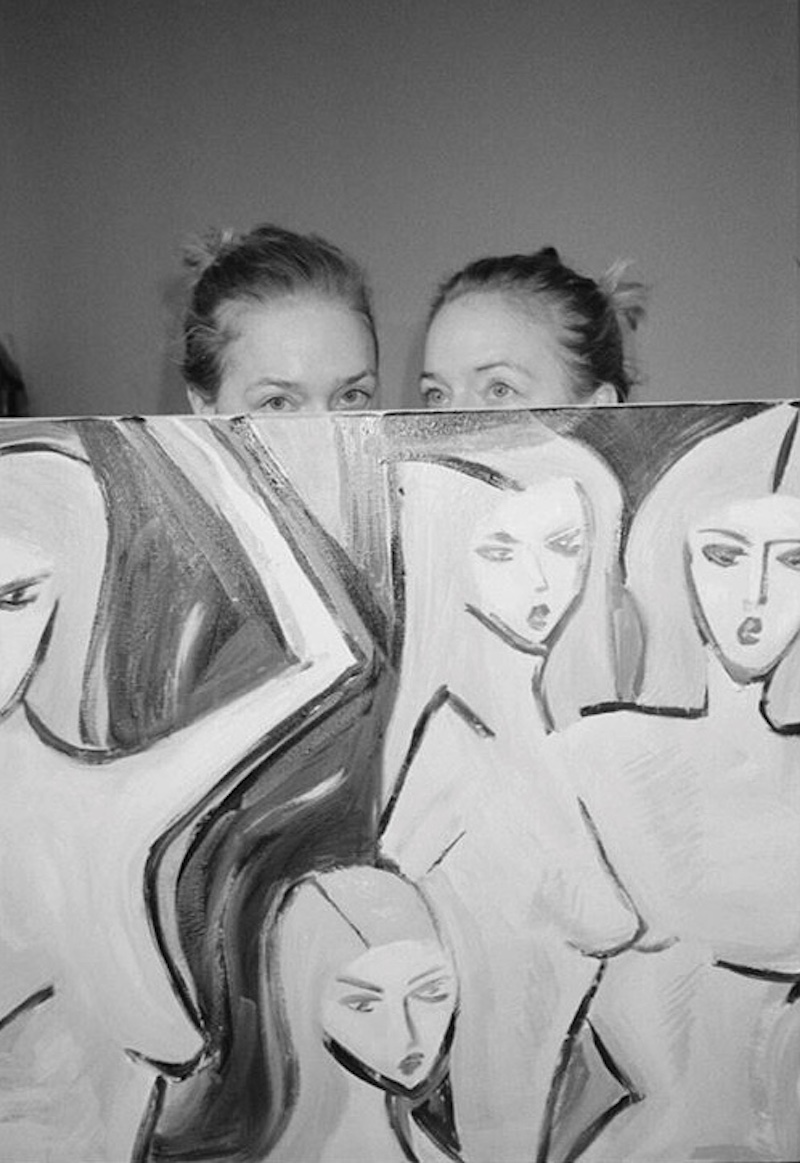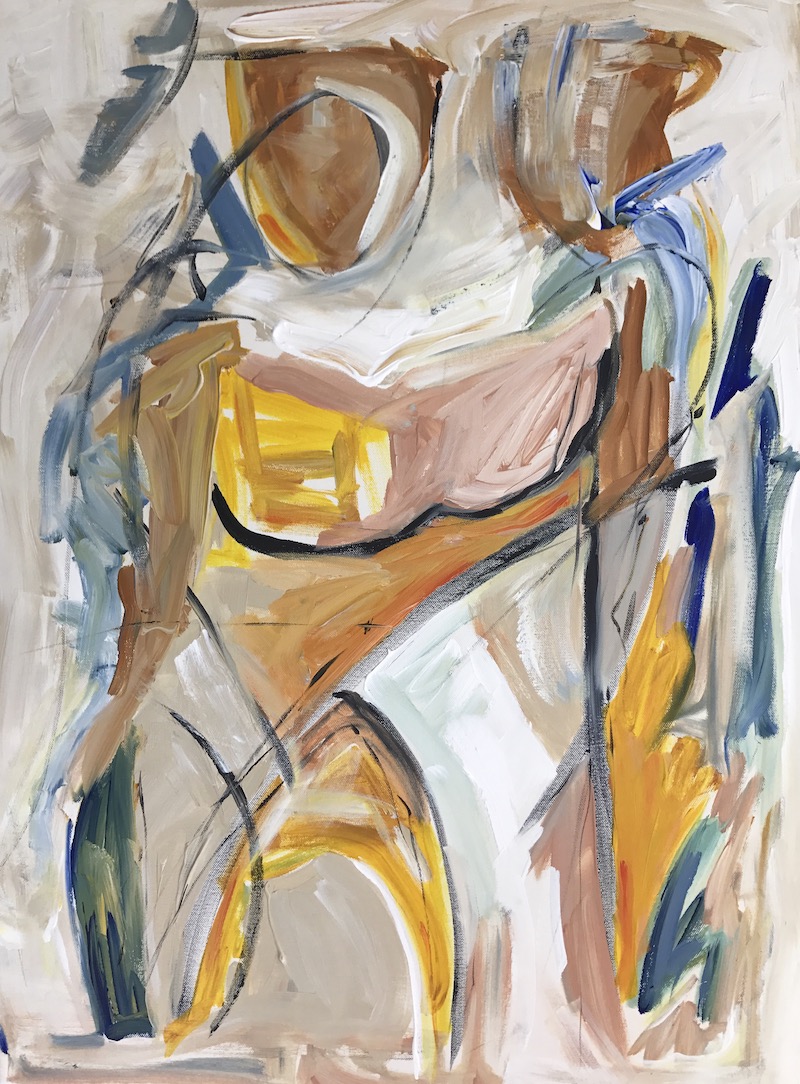
© Melanie and Stephanie Hausberger
Art is always a joint endeavour for Melanie and Stephanie Hausberger. Since their studies at the New York School of Visual Arts, the Austrian-born identical twin sisters have been creating all their works – especially drawings and paintings – together. Their visual language reveals the influence of art from the era of classical modernism – Pablo Picasso, Ernst Ludwig Kirchner, and above all, Egon Schiele shine through. Although their works are figurative and representational, they display a high degree of abstraction. After finishing their studies, Melanie and Stephanie Hausberger travelled a lot, but they have also set up a small studio in the Tyrolean Alps.
Jürgen Dehm: Melanie and Stephanie, how did you become familiar with art and artists while growing up in the Tyrolean Alps?
Melanie and Stephanie Hausberger: While living and going to school in Tyrol we weren’t really exposed to art, it's all about skiing and tourism here. Although our family always had classic art books in our house, and there was a great appreciation of art and culture in general, we didn’t go to museums and galleries. We started going to museums and art galleries by ourselves when we were around 15, and we also started reading a lot, about art, but also lots of literature and we discovered foreign magazines. So generally, we sort of educated ourselves, when it comes to art education in our childhood and adolescence.
JD: How has studying at the School of Visual Arts in New York changed your output?
MSH: It was during this time that we started to paint together on one canvas, which came about very organically. For us, it was not only more convenient, but also more exciting since you can’t really control the outcome as much as when you work on your own. We also had quite a few instructors at SVA, which were very influential to us and helped us to find our unique way to literalize an idea into a canvas. But generally, studying in New York City is the most exciting thing, we really loved it. One is exposed to contemporary art as well as the reminders of the art scenes of the 70s and 80s all the time. Everything feels just so interesting and exciting, and we were very much at home there. Living there for many years definitely shaped our aesthetics and overall, our whole beings. This combined with our Austrian upbringing made us who we are.
JD: After your studies, you worked as assistants for the French graffiti artist André. However, his street art seems to have influenced you very little, as you have continued to dedicate yourself to traditional techniques and form languages.
MSH: Yes, although we like his work very much, it didn’t directly influence us. We always were more drawn to traditional techniques of art. However, in all other areas in life we are very technology savvy. For now, we are happy with the traditional techniques and try to master them.

© Melanie and Stephanie Hausberger
JD: You always work on your paintings and drawings together. How balanced are the contributions you make?
MSH: It’s actually quite balanced, in the end, we mostly don't know who made what. It all just merges together.
JD: A major part of your works is based on the bodies and the outer shapes of both of you. How do you think the female body can be dealt with in contemporary art?
MSH: The female body has always been a subject in art – representing body ideals and the idea of perfection. But it always evolved and will continue to do so, probably going more into abstraction as we more and more start to define our very own ideals to which they aspire. For us, the depiction of the body is also about the relationship to one another and to ourselves, which again keeps changing. All that is immensely interesting to us.


© Melanie and Stephanie Hausberger
JD: In your Instagram Stories, you often post music and movie clips that are important to you. What shouldn't we miss?
MSH: We listen to music while working all the time, and film is also very inspiring to us. Unconsciously, what we see and listen to, all those images and sounds, moods and aesthetics of the films and music we listen to and watch, will one way or another end up influence what we make.We try to implement certain moods, and aesthetics from the films and music into our work. What we see and listen is stocking up our unconscious. Mostly we are drawn to classic and independent cinema. Since we watch quite a lot of movies it’s hard to pin down our favorites, but here are a couple of films we watched or rewatched recently: House of Hummingbird, 2018, Korean; Things to come, 2016, French; Reprise, 2006, Norwegian; Lost in Translation, US; Persona, 1966, Swedish; The music we listen to also tends to be quite classic, lots of Marvin Gaye, Prince, Fleetwood Mac but also more recent artists such as Dev Hynes.
JD: You have been working closely together right from the very beginning and were even living in the same bedroom during your New York days: Were there phases in your lives during which you were separated for a considerable time?
MSH: Yes, actually we feel we were separated quite a lot but just not in the last three or four years for several reasons. We always separated during the summer holidays when we were in High school. Usually one of us spent some time at our aunts in Tuscany the other in Tyrol, and then we switched of course. We both individually explored the cities and the art there and still feel a strong connection to Italy.
We also went to different schools, for about 2 years we actually didn’t see each other at all. One of us was in a boarding school in England, the other one in Austria. But we talked endlessly on the phone and wrote each other tons of emails. We tried separate schools in Austria, too, but it was not long until we ended up going to the headmaster demanding that we now both attend the same school. So, it seems we needed different countries to stay apart for a longer time. But then again, we somehow feel always connected, even when one of us is in NY and the other in Europe - which was often the case.


© Melanie and Stephanie Hausberger
JD: Where and how did you spend the past months?
MSH: Besides a couple of trips to Milan and Tuscany we mainly stayed in Tyrol where we have a small studio.
JD: Are there any advantages of the lockdown?
MSH: At the beginning quite a few, like having the time to breathe. But we tend to work quite isolated anyways, so in that sense little actually changed.
JD: And downsides?
MSH: The slow pace of many things, the lack of freedom to travel, and constantly being aware of the fact that many things used to be very different
JD: What are your plans for the future?
MSH: First Milan again, then going back to NYC. We got a one-year artist residency at Mana residencies, which we are very excited to start.

© Melanie and Stephanie Hausberger
